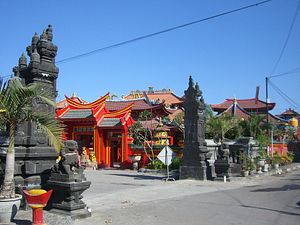In early April, 36 arts teachers from various provinces in Indonesia were invited for education and cultural communication training at the China Conservatory of Music (CCOM) in Beijing. During the three-week course, these teachers were taught various aspects of Chinese culture, including opera, traditional music, and calligraphy.
A few months earlier, in January, the first China-Indonesia Cultural Forum was also established between the Chinese consulate in Bali, Peking University, and Universitas Udayana. The forum is aimed at strengthening China’s cultural ties with Indonesia.
These two recent events epitomize China’s growing cultural footholds in Indonesia. Such endeavors have only intensified since the inception of the Belt and Road Initiative (BRI) in 2013, even though they still remain limited.
When Chinese President Xi Jinping initiated the BRI, he understood the importance of using cultural activities in its implementation. The “Vision and Actions on Jointly Building Silk Road Economic Belt and 21st-Century Maritime Silk Road,” the BRI’s main strategy document, emphasizes “cultural exchange” as a vital part of the realization of the initiative. These cultural exchanges seem to have turned into a crucial platform to boost partnership with the countries impacted by the BRI, including Indonesia.
In fact, as soon as the BRI was announced in 2013, the government in Beijing signed a cooperation agreement on cultural exchange with Indonesia. This agreement has been realized through various cultural activities in the following years.
One such example took place in Jakarta in September 2018, when Peking opera star Chu Lanlan cooperated with an Indonesian firm to hold a cultural event in support of the BRI. A similar event was also organized in Jakarta earlier in 2017, with the stated aim to strengthen China’s relations with Indonesia. The event, which was attended by the first vice prime minister of China, Zhang Gaoli, exhibited many aspects from Chinese culture such as traditional dance and martial arts. In the same year, Beijing also cooperated with Jakarta in organizing the China-Indonesia Social Relations Archives Exhibition in Beijing. The event showcased various archives owned by Indonesian National Archives (ANRI), State Archives Administration of China (SAAC), as well as the Archives of Fujian Province.
Similar events were also held in various cities in Indonesia throughout that year, such as the 2017 China-Indonesia Cultural Festival in Malang, East Java, and in Jakarta a joint cultural performance and Lantern Festival celebrations in 2017.
Besides cultural events, the endeavors also include more academic activities. For example, a number of public academic discussions on the roles of culture in China-Indonesia relations have also been held, such as in Jakarta in October 2016.
In order to support these growing cultural exchanges, institutions have also begun to be built. In September 2018, for example, the Chinese government agreed to build the first center for cultural exchange under the BRI in Bali. The planned 10,000 square meter center is located in Gunung Batur, Bali and is envisioned as a place for China and Indonesia to get to know their respective cultures. Media Indonesia also reported that there will be an orphanage and a trilingual (English, Bahasa Indonesia, and Chinese) university built in the area.
In the field of tourism, the Indonesian government’s policy to grant visa-free visits to Chinese citizens has contributed greatly to increasing the number of Chinese tourists visiting Indonesia. In 2016, China was the largest source of tourists visiting the country with a total of 1,340,760 people, while the number of Indonesian tourists visiting China in 2015 reached 544,800 people. This number is expected to grow as the government in Jakarta has been exerting efforts to further attract Chinese tourists.
While China’s cultural efforts in Indonesia cannot be ignored and may have contributed to the growing ties between the two countries, the impact remains limited.
Aside from being limited and not pursued evenly across Indonesia, the cultural activities being carried out still revolve around socializing Chinese cultural elements, not on establishing a common vision or addressing the prevalent anti-Chinese sentiments in Indonesia. As a comparison, in Africa, it is reported that cultural outlets have been used to promote how Chinese investments may benefit the people there.
Having said that, the examples above still provide evidence that China’s footholds in Indonesia are not restricted to the economic sphere, but are beginning to expand into cultural realms. With the BRI is being actively realized, Indonesia needs to be ready for China to expand and improve these strategies in search of stronger traction within the country. This is a development that is likely to unfold over the next few years. As Xi himself has stated, “Preparatory work must be done. One must not worry about it taking too long, for the work will be accomplished in the fullness of time.”
Dr. Muhammad Zulfikar Rakhmat is a lecturer at Universitas Islam Indonesia and a research associate at Jakarta-based Institute for Development of Economics and Finance (INDEF).

































